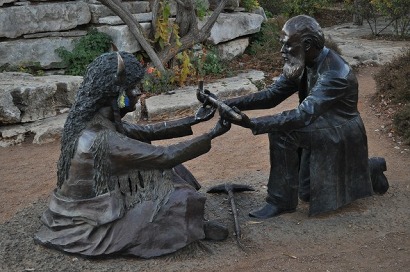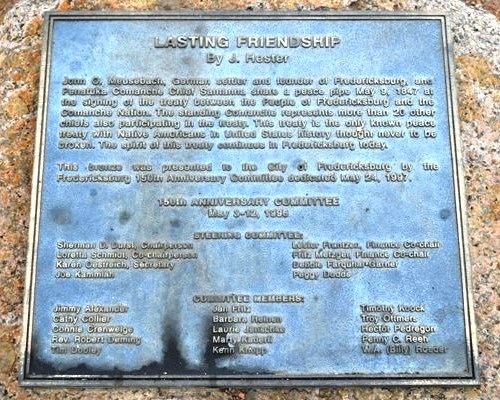|
Books by
Jeffery Robenalt
|
|
|
In
early spring of 1847, a remarkable treaty between German settlers
and Native Americans was negotiated on the banks of the San Saba
River in the hill
country north of Fredericksburg,
Texas. The unlikely parties to the long-standing agreement,
that was to eventually open up nearly four million acres for settlement,
were a former German baron and the representatives of the fierce
Penateka Comanche tribe.
Seeking to solve the problems of political unrest and overpopulation
facing mid-nineteenth century Germany by advocating immigration
to the Republic of Texas,
an organization of German noblemen known as the Society for the
Protection of German Immigrants purchased a large tract of land
in Texas. The land in question was part of the Fisher-Miller Land
Grant that stretched between the Llano and San Saba rivers. Unfortunately,
the Society purchased the land with little knowledge of the Texas
frontier and fell victim to a disreputable businessman, Henry Francis
Fisher. Fisher knew well that the land in question was inhabited
by far too many war-like Comanches to be suitable for settlement.
|
|
Enduring much
hardship on their journey from the Gulf
Coast, 439 German immigrants eventually made their way to central
Texas. However, the Society’s first attempt to populate the Fisher-Miller
Land Grant stalled at the settlement of New
Braunfels due in part to the financial mismanagement of Prince
Carl of Solms-Braunfels, the first commissioner general of the enterprise,
and the refusal of surveyors to enter a land grant infested by the
much feared Penateka Comanches. To make matters worse, 4000 new
immigrants were on the way to the new colony from Germany.
|
|
|
John
O. Meusebach
Wikimedia Commons |
|
The burden of
untangling this web of deceit and mismanagement fell on Prince Carl’s
successor, Baron Otfried Hans von Meusebach. Upon his arrival in
Galveston
in May 1845, Meusebach put aside his title of German nobility, adopted
the name John O. Meusebach, and rode to New
Braunfels. There Meusebach learned that in addition to the Society’s
wretched financial condition, and the Comanche problem, according
to the original contract with the Republic
of Texas, the Fisher-Miller Land Grant was subject to forfeit
if the land was not settled by August 1847.
In May 1846, Meusebach moved closer to satisfying the Society’s
obligation to settle the land grant by founding the community of
Fredericksburg.
However, in November the former baron received word of the 4000
new immigrants who were on their way from Germany. There was only
one possible solution to the problem of settling so many people.
Somehow Meusebach had to accomplish the seemingly impossible by
reaching an agreement with the Comanches to open the vast tract
of land to settlement that lay between the Llano and San Saba rivers.
On January 22, 1847, Meusebach rode out of Fredericksburg
with a company of forty men and three wagons and headed for the
heart of the Comancheria. Included in the company was interpreter
Lorenzo de Rojas who had been kidnapped by the Comanches as a child.
The expedition’s ultimate goal was to secure a treaty of peace with
the Comanches.
Soon after the expedition’s departure, Indian agent Robert S. Neighbors
arrived in Fredericksburg
with a message from Texas Governor
Pinckney Henderson, urging Meusebach not to venture into Comanche
territory for fear that the act would further arouse the already
hostile Indians. Accompanied by Dr. Ferdinand von Roemer, who had
been sent to Texas by the Berlin Academy
of Sciences to evaluate the mineral assets of the land grant, Neighbors
set off in pursuit of Meusebach’s party.
On February 5, Meusebach’s expedition was met by a party of Comanches
carrying a white flag, and after mutual assurances of their peaceful
intent, the parties shared a meal. The following day the Comanches
led Meusebach and his men to their main camp on the San Saba. The
entire camp rode out to greet the German settlers, everyone mounted
including the women and children.
At the urging of his interpreter, de Rojas, Meusebach ordered all
forty of his men to raise their rifles and discharge them into the
air, thereby disarming themselves as the huge party of Comanches
neared. Some of the men thought the act foolhardy, but it served
to build the Comanches’ trust, and in light of the overwhelming
numbers of warriors present, was most likely the only rational course
of action to follow.
Neighbors and Roemer arrived at the San Saba campsite on February
10, while Meusebach was waiting for the remainder of the Comanche
chiefs to assemble for the peace council. In his carefully written
accounts, Roemer noted Meusebach’s courage in walking among the
Comanches unarmed, a habit that earned the German the respect of
the Indians. They even honored him with the name El Sol Colorado
or the Red Sun, in part because of his flowing red beard. Among
the more prominent Comanche leaders who gathered at the assembly
were the political chief Old Owl, short and frail in stature, the
tall muscular war chief, Santa Anna, and the dour Buffalo Hump,
famed warrior and leader of the Great
Comanche Raid of 1840.
During the negotiations which began on March 1, and ended on the
following day, Meusebach’s lack of prejudice toward the Indians,
a view seldom shared by most whites, was reflected in his opening
words to the assembled chiefs. “I do not disdain my red brethren
because their skin is darker, and I do not think more of the white
people because their complexion is lighter.” Meusebach also stressed
that his people were neither Texan nor Mexican, two peoples the
Comanches hated the most. Even more important than his words, however,
were the terms of peace offered by the former German baron.
|
 |
 |
Unlike most
Indian treaties which were usually no more than articles of surrender,
heavily weighted in behalf of the whites, the treaty offered by Meusebach
provided for an equal balance of recognition and dignity as between
good friends and allies. First, the Comanches agreed to share their
hunting grounds with los Alemanes and grant the German settlers
and the Society’s surveyors free access to the land between the Llano
and the San Saba Rivers in exchange for $3000 in presents and supplies.
The Germans also granted the Comanches free access to their settlements
to “go wherever they please,” and finally, both sides agreed there
would be mutual reports of any wrong doing.
On March 3, the Germans loaded their wagons and began the return trip
to the settlements. The company was soon joined by a large band of
Comanches, including women and children, under the leadership of Santa
Anna. After crossing the Llano River on March 5, the Germans and Comanches
shared a camp near Enchanted
Rock the following evening, and reached Fredericksburg
the next afternoon. The company’s arrival happened to fall on a Sunday,
and Meusebach and his men were greeted by a festive crowd dressed
in their colorful best who, according to Roemer, “rejoiced when they
saw us return at the head of and in peaceful association with a troop
of Comanche Indians.”
The Meusebach-Comanche Treaty opened up a vast stretch of land for
settlement that would one day become all or part of ten Texas counties;
a total of nearly four million acres. Other than the presence of Indian
Agent Robert Neighbors at the negotiations, the United States played
no part in the treaty except to later recognize it. The agreement
reached on the banks of the San Saba River remains the sole treaty
negotiated between a Plains Tribe and settlers as private parties,
and is believed to be the only pact between whites and Native Americans
that was never broken. The Meusebach-Comanche treaty was truly an
achievement of note by John O. Meusebach, a man of determination,
courage, and vision.
© Jeffery
Robenalt
"A Glimpse of Texas Past"
August
1, 2012 Column
jeffrobenalt@yahoo.com
References >
|
References
for "The Meusebach-Comanche Treaty"
|
|
Davis, Joe
Tom (1982), Legendary Texans, Eakin Press, Austin, TX, ISBN
0-89015-336-1.
Fehrenbach,
T.R. (1968), Lone Star: A History of Texas and the Texans,
Macmillan Publishing Company, New York, NY, ISBN 0-02-032-170-8.
Jefferson,
Morgenthaler (2007), The German Settlement of the Texas Hill
Country, Mockingbird Books, ISBN 978-1-932801-09-5.
King, Irene
Marschall (1987), John O. Meusebach, University of Texas
Press, Austin, TX, ISBN 978-0292740198.
Smith, Cornelia
Marschall; Tetzlaff, Otto W. "Meusebach, John O." Handbook
of Texas Online (http://www.tshaonline.org/handbook/online/articles/fme33),
accessed May 3, 2012, Published by the Texas State Historical Association.
|
|
|
